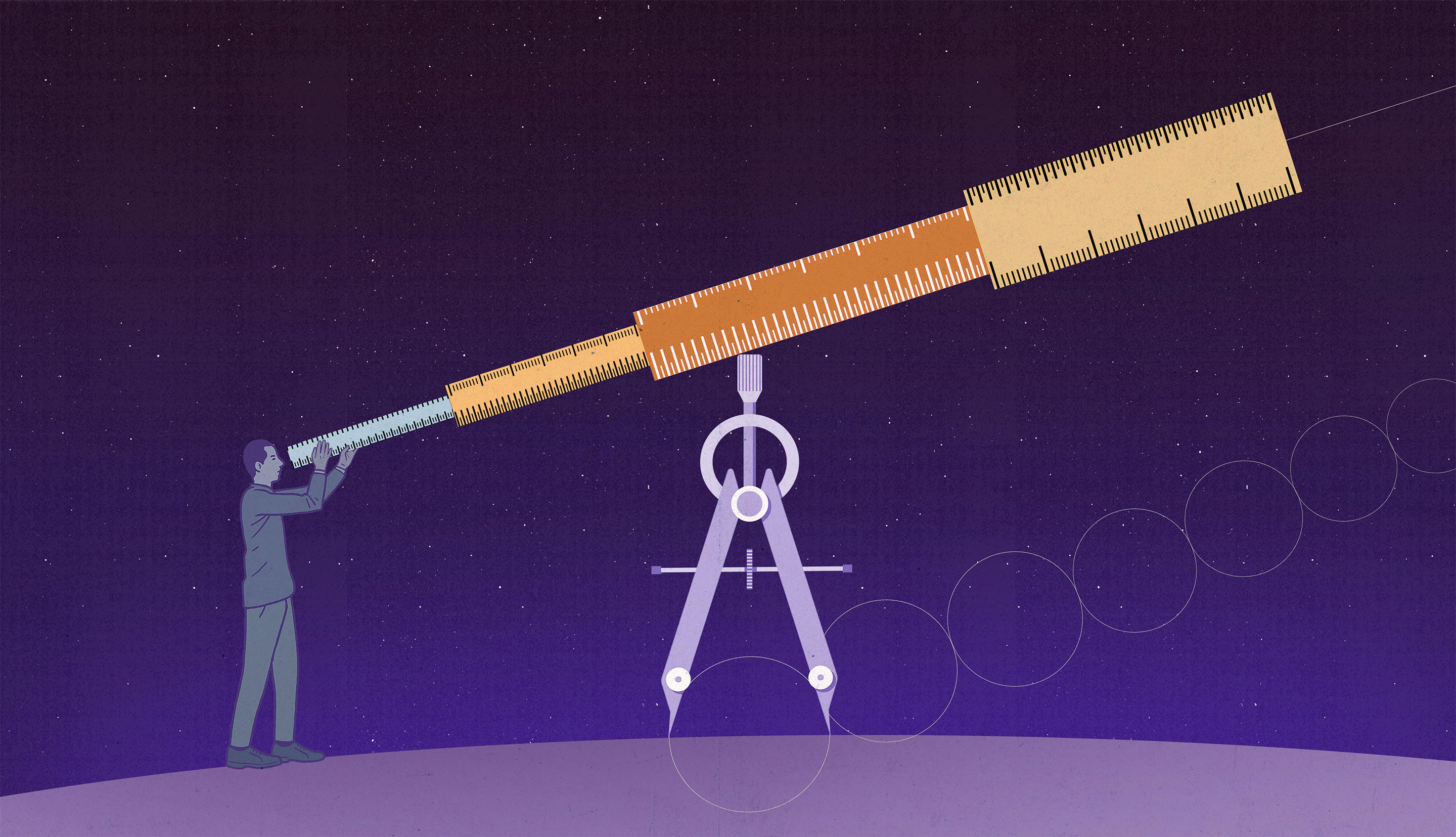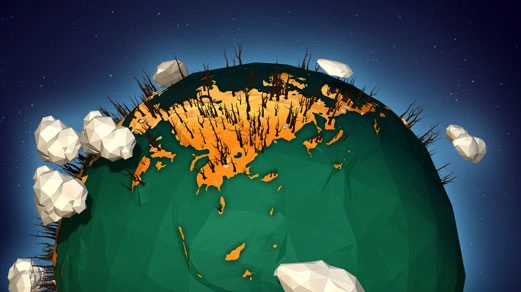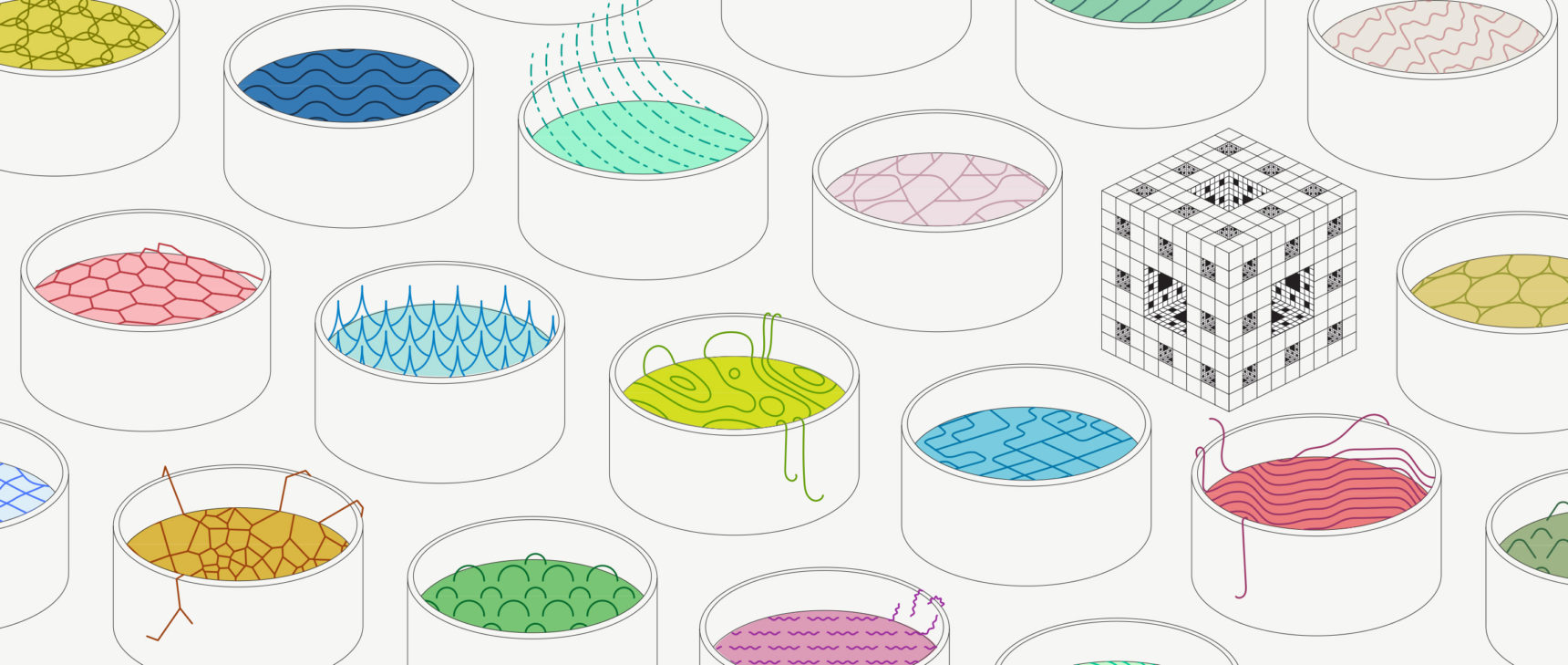How Triangulation Leads to Knowledge

Dan Page for Quanta Magazine
Introduction
One of the “game changing” pieces of scientific news in 2017 concerns the collision of two neutron stars about 130 million light-years away, first detected on August 17. One reason astronomers and cosmologists are so excited is reflected in the title of Natalie Wolchover’s article “Colliding Neutron Stars Could Settle the Biggest Debate in Cosmology.” The debate concerns the famous Hubble constant, which tells you how fast the universe is expanding: It is the ratio of how fast any object in the universe is receding from us to its distance from us. Ever since the American astronomer Edwin Hubble first discovered that the universe was expanding in 1929, it has proven very hard to determine the value of this constant accurately. As Wolchover explains:
It’s relatively easy to see how fast a star or galaxy is receding by looking at its “redshift” — a reddening in color that happens for the same reason the sound of a receding ambulance’s siren drops in pitch. … Historically, however, it has proven much, much harder to measure the distance to an object — the other data point needed to calculate the Hubble constant.
For centuries, surveyors have used a method called triangulation to calculate the distance to an object without physically traveling to it. It is based on the simple principle that if you know the length of one side of a triangle and two of its angles, then you can determine the length of the other two sides using elementary trigonometry. Here’s a simple problem that gives a feel for this.
Problem 1
You are sailing on the ocean and spot a bright light from a lighthouse due south. You sail on an easterly course for 30 nautical miles. You get bearings on the lighthouse again and find that it is now 53.13 degrees south of west. How far was the lighthouse from you when you first spotted it? How far is it from you now?
If you recall even a little high school trigonometry, this problem is easy. But it presupposes that all your measurements were accurate, which they probably were, since we do have very accurate, well-calibrated means to measure angles and traveled distances.
That’s not the case for astronomical objects, however. You can calculate distances to nearby heavenly objects such as the other planets in our solar system and even some of the closest stars using a parallax technique similar to the triangulation described in the problem above. This doesn’t work for stars that are farther than a certain distance, and so, to quote Wolchover again:
Astronomers have to build a ‘cosmic distance ladder’ in which each rung calibrates more-distant rungs. … With this information, astronomers can deduce the brightness of so-called Cepheid stars, which can be used as so-called ‘standard candles’ because they all shine with a known intrinsic brightness. … Next the Cepheids are used to calibrate the distances to Type Ia supernovas — even brighter (though rarer) standard candles that can be seen in faraway galaxies. Each jump from one rung to the next risks miscalculation.
As you can see, astronomical distance measurements involve building a chain of assumptions that introduce possible error at every step.
How much does triangulation help us in the face of uncertainty? Well, it cannot give us absolute accuracy, but it can reduce our uncertainty. Let’s get a feel for this.
Problem 2
Let’s revisit the scenario of Problem 1. Assume that you live on a planet on which there is a phenomenon of “optical wind” that causes lensing effects so that you can be sure that your estimates of the direction of an object are accurate only within ±2 degrees. So all you can say is that the lighthouse is somewhere between 2 degrees west of south and 2 degrees east of south. Also, you know (or think you know) how intrinsically bright the source of the light is — it is a “standard candle” — and from this you can infer its distance from you to an accuracy of ±5 percent. Based on this, you can narrow down the area in which this lighthouse is situated. How large is this area?
Now suppose you triangulate as before. With the aid of the optical wind, you sail 30 nautical miles (which you can measure accurately, of course) and then again find the lighthouse to be 53.13 degrees south of west, this time with an error of ±2 degrees. You can also infer the distance to the lighthouse with ±5 percent accuracy. By triangulating this new measurement with your previous one, you can narrow down the area in which the lighthouse is situated. How much reduction can you achieve?
If you are not confident that you have mastery of the mathematical tools to answer this, just draw a scale diagram and estimate it. You can post your diagram in the comments section.
As you can see, triangulation again helps in reducing uncertainty in the distance estimate. Unfortunately, we can’t use it to find the Hubble constant more accurately because of the large distances involved. And so there has been a standoff between two methods to calculate cosmic distances: One gave the value of the Hubble constant as 67 km/sec/megaparsec and the other gave 73 km/sec/megaparsec.
And that’s where the crashing neutron stars come in. They send out gravitational waves that, as the astrophysicist Daniel Holz explains, allow you to “directly infer the distance to the source. There is no distance ladder, and no poorly understood astronomical calibrations. You listen to how loud the [collision] is, and how the sound changes with time, and you directly infer how far away it is.” The crashing stars serve as “standard sirens,” as Holz and Scott Hughes of the Massachusetts Institute of Technology called them. We now have the potential to reach the kind of accuracy in cosmic distance measurements that surveyors of the Age of Exploration achieved on Earth with their accurate clocks, compasses and theodolites. We just have to wait a few more years for more neutron star crashes in the universe to happen, to hone the accuracy of our measurements. This new method will now triangulate the older ones, almost certainly giving far greater accuracy.
What fascinates me about the process of triangulation is that we naturally use a similar process to reduce uncertainty when we deduce facts about the world. I call it “cognitive triangulation,” and it is even more effective than numerical triangulation. It is based on the fact that when we encounter an unknown phenomenon, we try to connect it with things that we already know. Using some line of reasoning that seems natural, we, consciously or unconsciously, construct a hypothesis that may be plausible, but is unconfirmed. However, if we can come up with a completely independent line of reasoning that gives us the same answer, we immediately take notice. Our brains cement our conclusions with an “aha!” moment, accompanied by feelings of joy and certainty — no doubt because two independent lines of thought arriving at the same conclusion are much more likely to be caused by some regularity of the world than by sheer coincidence.
My favorite anecdote about this phenomenon involves the writer Isaac Asimov. When he was a young boy, having just learned how to read, his family took him on a picnic to Coney Island. As they stood on the railway platform, a train approached with the words “Coney Island” written on it. The young Asimov, exercising his newfound reading skills, started parroting to himself “Coney Iz-land, Coney Iz-land,” voicing the “s” in “island.” Suddenly, he had an intense “aha!” moment — so intense that he felt compelled to write about it in his autobiography. In a flash of illumination, he realized both that Coney Island was the train’s destination and that some letters in English spellings are silent. Both of these were plausible hypotheses, possibly buried in his subconscious, that his brain had triangulated, thus strengthening both and leaving him in no doubt about either.
Instances of such “cognitive triangulation” — in which the same answer emerges from two independent methods, strengthening both — abound whenever puzzles are solved, whether for recreation or to advance science. In the puzzle world, you have crosswords in which two words with their own independent clues fit together by means of a common intersecting letter, mutually strengthening the plausibility of both. Cryptic crossword clues, as illustrated in Quanta’s 2017 year-end crossword, also make use of cognitive triangulation by pointing to the answer in two different ways, giving complete certainty when you get the right answer. In jigsaw puzzles, the same thing happens, where both the shape of the piece and the picture on it need to fit their surroundings properly to fill an empty space.
And of course, the same thing happens in science. The theory of biological evolution is so well established because the evidence for it from so many independent sources of inquiry — paleontology, genetics, biochemistry, cladistics, morphology — fits so well together. In fact, cognitive triangulation is one of the primary ways that we learn about the world both as individuals and scientists, as we process the information that comes from our various sense modalities, correlating vision with hearing, vibration with touch, and so on. With this in mind, I have a strange-sounding puzzle question for you. Its answer gave me an “aha!” moment when I first encountered it.
Problem 3
What does cognitive triangulation between sense modalities have to do with motion sickness?
I would also love to read about your “aha!” experiences, in everyday life or in scientific activity, that came from cognitive triangulation and gave you instant certainty that some conclusion you reached was correct.
Happy puzzling!
Editor’s note: The reader who submits the most interesting, creative or insightful solution (as judged by the columnist) in the comments section will receive a Quanta Magazine T-shirt. And if you’d like to suggest a favorite puzzle for a future Insights column, submit it as a comment below, clearly marked “NEW PUZZLE SUGGESTION.” (It will not appear online, so solutions to the puzzle above should be submitted separately.)
Note that we may hold comments for the first day or two to allow for independent contributions by readers.
Update: The solution has been published here.



